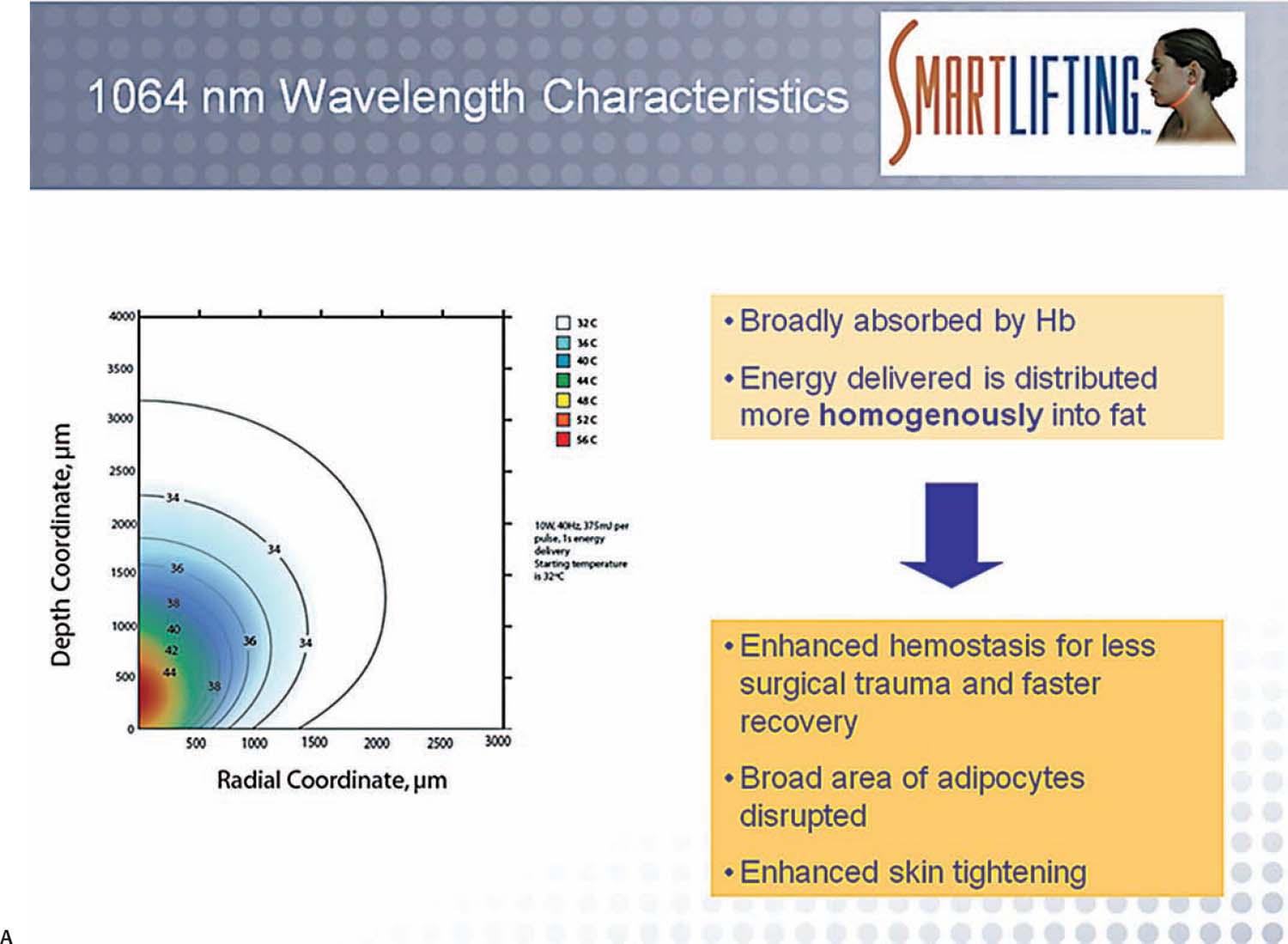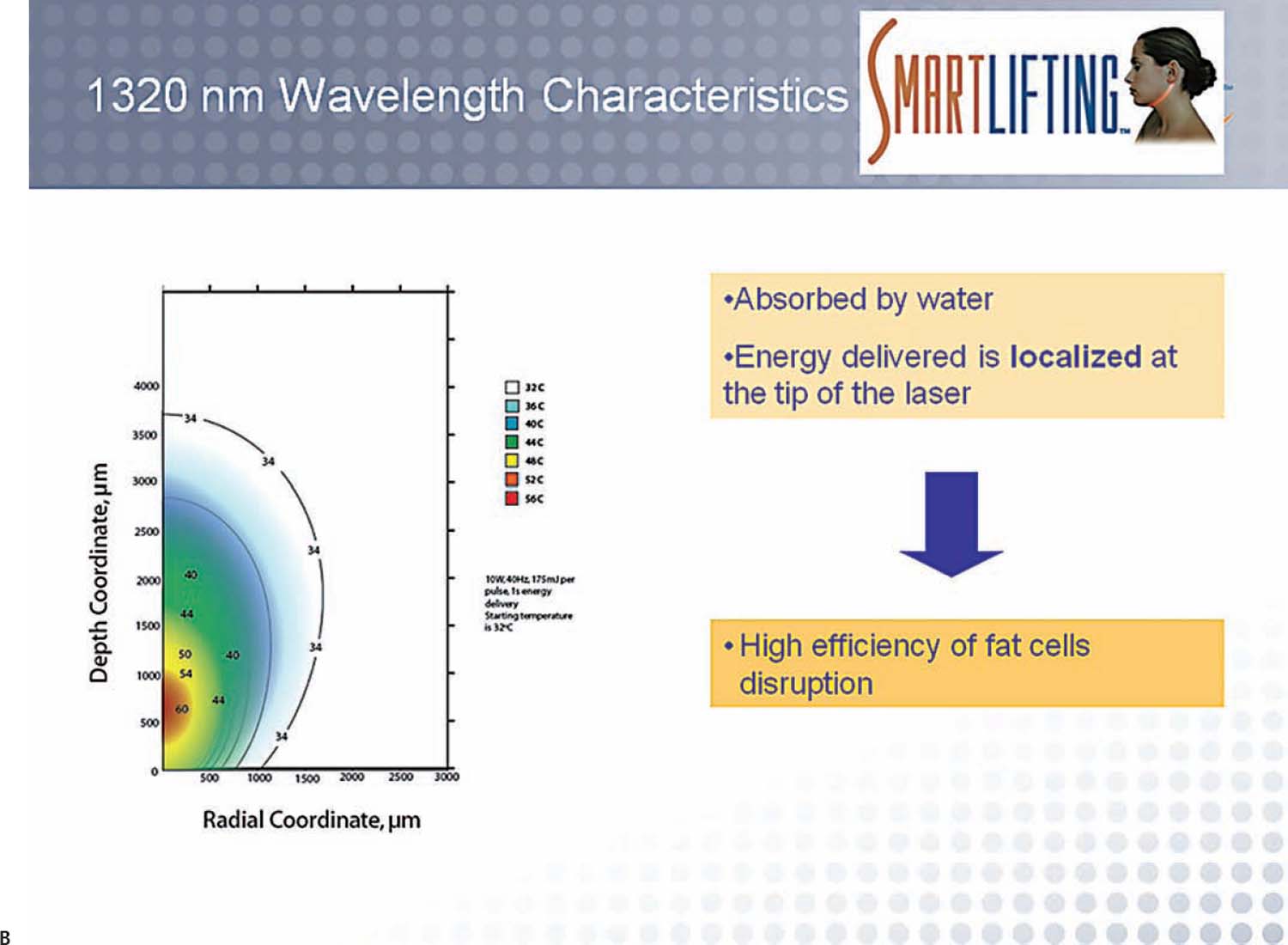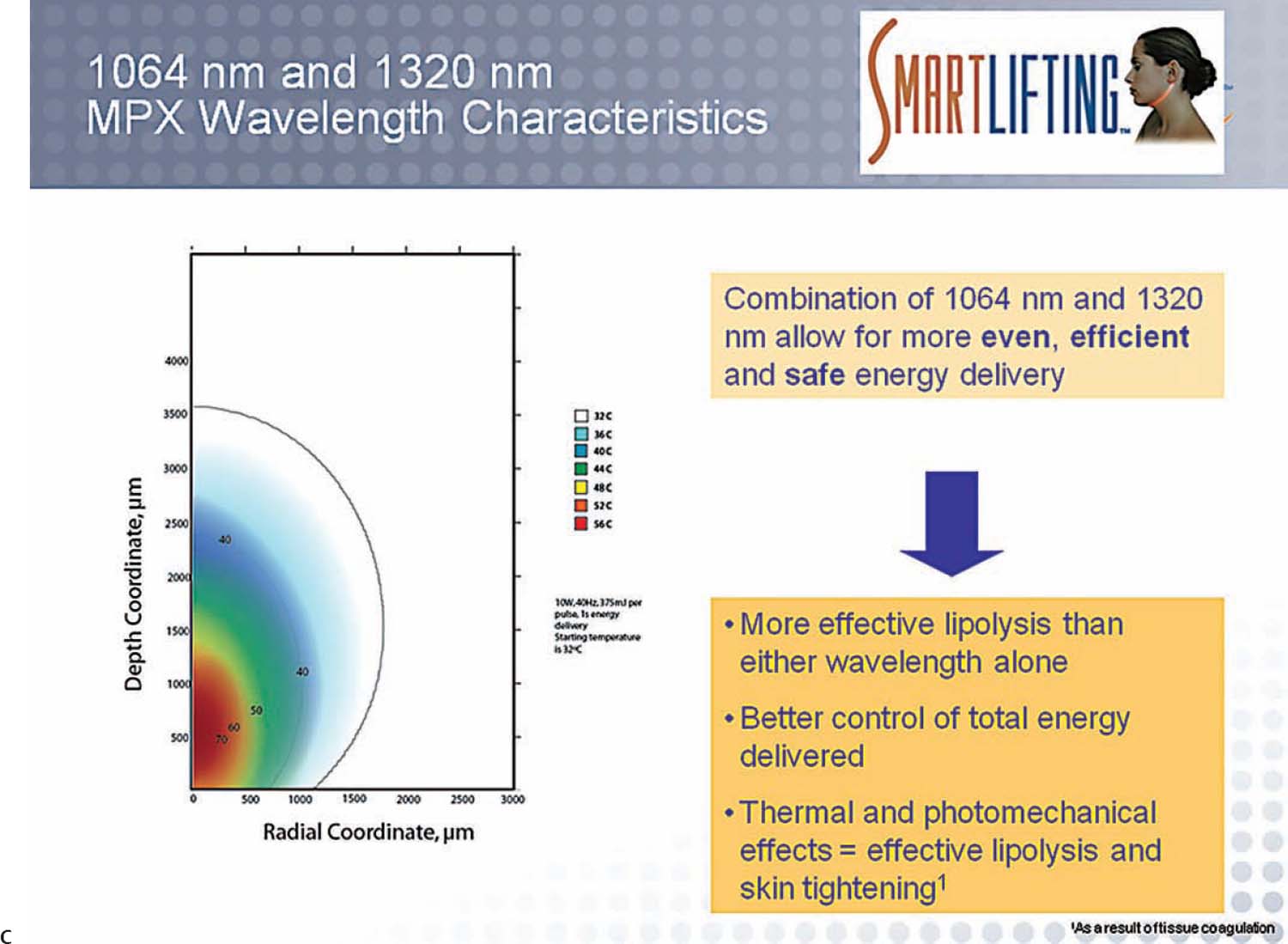12 Less-invasive procedures for facial rejuvenation are becoming increasingly popular as prospective patients seek treatment options that offer the best possible results with the least time lost for treatment and recovery. As the demand for “rapid recovery” procedures increases and patients spend more time researching their treatment options, they are making more informed choices and often opt for technologically advanced procedures. The encounter between advanced technology and aesthetic surgery has been characterized by several different technological shocks, consisting in this case of the introduction of a new aesthetic technology that is rapidly and favorably integrated into mainstream aesthetic practice. The first such technological shock occurred in the early 1990s with the introduction of laser rejuvenation of the skin for treating rhytids and actinic skin damage. The advent of radiofrequency approaches to skin tightening is considered another technological shock, as has been the effect of lasers in aesthetic surgery since 2006 and the fractional approach to laser rejuvenation of the skin, introduced to aesthetic surgery at about the same time and rapidly integrated since then into clinical practice. One might ask how it is possible to assess the impact and potential benefit to patients of technological innovations. Although this has never been reviewed, we (R.D.G.) would like to suggest parameters that would correlate with the significance of the technological innovations being introduced into aesthetic surgery. As shown in Table 12.1, which details technological innovations and transformational change in aesthetic surgery, the criteria for assessing improved outcomes in procedures aided by technology should provide details of what the technology adds to current practice or conventional methods. We list five criteria for assessing potential benefits of the use of a specific innovation, and would infer that the more of these criteria the technological innovation fulfills, the more likely it is to become an important innovation for clinical aesthetic practice. Likewise, those innovations meeting few criteria will most likely not be long lived in clinical aesthetic practice. Patients are now more informed about aesthetic technology than ever, and are more likely to undergo technology-aided procedures, and especially those perceived as reducing the recovery period, reducing risk such as anesthetic risk, or improving the outcome of treatment. One such procedure is laser-assisted facial rejuvenation or SmartLifting with the SmartLipo laser for laser lipolysis and skin tightening through tissue coagulation. SmartLifting is a new technique designed as an adjunct to advanced surgical facial rejuvenation procedures such as rhytidectomy. It provides a revolutionary and minimally invasive procedure in which a high peak-powered laser is used to aid in tissue separation with simultaneous skin tightening through tissue coagulation. The history of laser lipolysis is a relatively brief one and has been summarized well by Dibernardo,1 who notes that Apfelberg2 is credited for describing the laser–fat interaction in 1992. Publications by Blugerman,3 Schavelzon,4 and Goldman5 followed, in which they demonstrated their own experience with lasers used on adipose tissue. Badin6 high-lighted the important tissue retraction that he noted with his technique of laser lipolysis. Ichikawa7 published on the histological evaluation of tissue treated with laser lipolysis, showing the destructive changes in heat-coagulated collagen fibers and degenerated fat-cell membranes, with dispersion of lipid after the laser irradiation of human specimens. These histological changes correlate with clinical changes induced by laser lipolysis as seen by both physicians and patients. Further, the hemostatic properties of the 1064-nm wavelength at which laser lipolysis is conducted have been well documented. The thermal effect of the Nd:YAG laser (which emits radiation at 1064 nm) on adipose tissue promotes better hemostasis, reducing surgical trauma and allowing wound healing with fewer adverse sequelae. In addition to histological evidence, clinical evaluation shows improved postoperative recovery with laser lipolysis, resulting in a more rapid return to daily activities and an excellent aesthetic result. The application of laser lipolysis to rejuvenation of the face and neck, in conjunction with the advanced facial rejuvenation techniques of SmartLifting, was introduced by Gentile in 2007.8 The initial procedures were performed with the SmartLipo 1064-nm laser, but with the introduction of the SmartLipo MPX, later procedures were done with this 1064-/1320-nm multiplexed laser. Table 12.1 Criteria for Being Considered as Technologic Innovations Mediating Transformational Change in Aesthetic Surgery
Laser Facial Sculpting, Laser Lipolysis, Smartlifting, and New Technologies for Rejuvenation of the Aging Neck
Reduces anesthetic requirements for procedure Reduces operating time for procedure Reduces complications or morbidity for procedure Reduces recovery time for procedure Facilitates new technical approaches lacking in conventional or existing techniques Criteria for assessing improved outcomes in aesthetic surgery resulting from technology |
The Introduction of the Subcutaneous Laser for Rejuvenation of the Face and Neck
The SmartLipo laser (Cynosure, Inc., Chelmsford, MA) was the first laser to be approved by the U.S. Food and Drug Administration (FDA) for laser lipolysis. In addition to its indication for laser lipolysis, the SmartLipo laser is approved for the surgical incision, excision, vaporization, ablation, and coagulation of soft tissue. All soft tissue is included in this indication, which applies to skin, cutaneous tissue, subcutaneous tissue, striated- and smooth-muscle tissue, cartilaginous menisci, mucous membranes, lymph vessels and nodes, organs, and glands. Following the 2006 introduction of subcutaneous laser-based “lipolysis” techniques, many laser manufacturers besides Cynosure have introduced products for laser lipolysis and many have introduced different wavelengths for the specific indication of laser lipolysis. Wavelengths for laser lipolysis other than the 1064-nm and 1320-nm wavelengths described above include 980 nm and 1444 nm.
Subcutaneous Application of Optical Energy and the Laser–Tissue Interaction
The original SmartLipo laser (Fig. 12.1) delivered optical energy at a wavelength of 1064 nm though a 300-μm-diameter fiber at a power of 6W (Fig. 12.2A). All subsequent Cynosure SmartLipo and SmartLipo MPX lasers have utilized a 600-μm-diameter optical fiber (Fig. 12.2B), and now use a 1000-μm-diameter fiber (Fig. 12.2C) for high-power laser lipolysis. The 600-μm optical fiber is introduced into a 1-mm-diameter stainless steel microcannula of variable length and is used for laser-assisted procedures on the face. The laser is fired through the distal end of the optical fiber, which protrudes 2 mm beyond the tip of the microcannula. The distal end of the fiber interacts with the soft tissue of the face and neck. For visualization, an aiming source in the path of the laser beam provides the precise location of the emitting tip of the fiber, indicating where the laser is working. For most anatomical regions of the face and neck, a 6 to 12W, 100-μs pulsed laser beam at a frequency of 40 Hz and energy of 150 mJ has been used. The Smartlipo MPX laser, which can blend the 1064-nm and 1320-nm wavelengths that it is capable of emitting, was used in more recent Smartlifting studies for laser lipolysis and laser-assisted facial and neck lifting, and is currently used in completing these procedures. The Nd: YAG laser produced photomechanical and thermal effects, which dissected treated tissue quickly and easily. In addition to this, the Nd:YAG laser’s hemostatic properties included the coagulation of small blood vessels in the subcutaneous plane with preservation of the vascular dermal plexus.
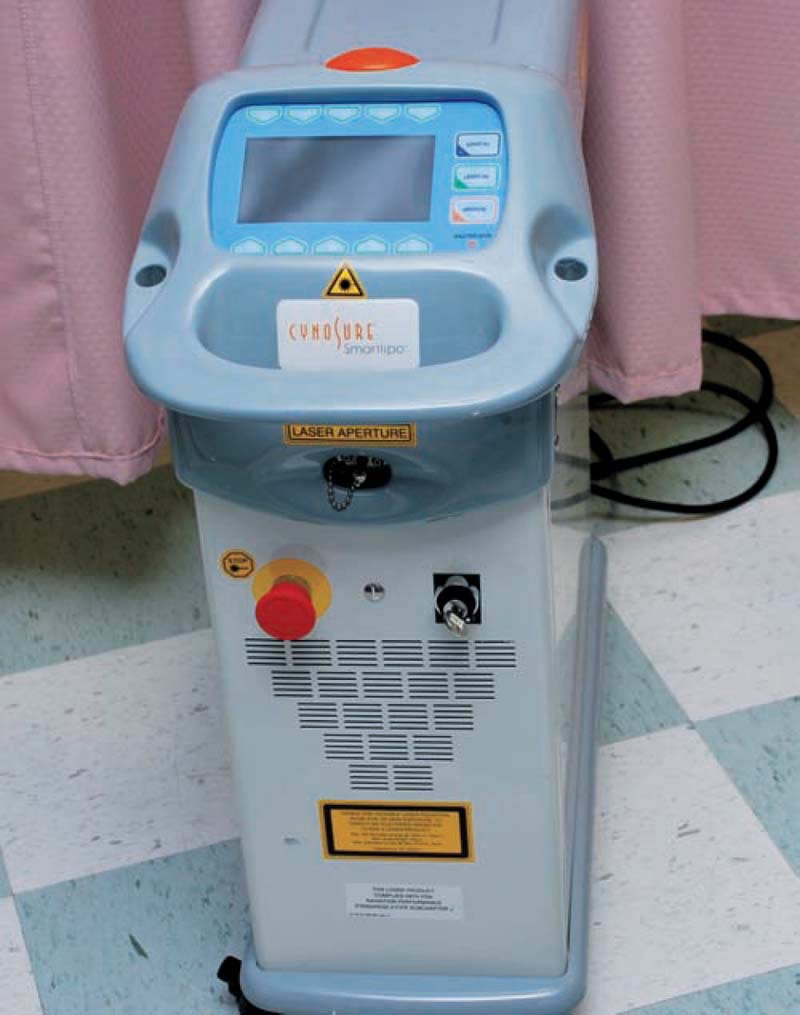
Fig. 12.1 Small-footprint SmartLipo 1064-nm Nd:YAG laser. The Smartlipo laser was initially approved at 6W and underwent power upgrades to 18W before the introduction of the SmartLipo MPX and SmartLipo TriPlex lasers.

Fig. 12.2 (A) Original 300-μm fiber used for lipolysis and tissue coagulation. (B) The 600-μm fiber. (C) The 1000-μm fiber.
Multiplexing of the 1064-and 1320-nm wavelengths of laser radiation offers several unique advantages. The SmartLipo technique with the MultiPlex laser (i.e., the SmartLipo MPX) (Fig. 12.3) allows the separate as well as sequential emission of radiation at 1064-nm and 1320-nm. Sequential firing at these two wavelengths in combination with one another maximizes the positive properties of each. The combination of these two wavelengths increases the efficiency of lipolysis and offers a more evenly distributed laser-energy profile, which benefits superficial and deep treatment. When emitted sequentially, energy at these two wavelengths provides more efficient coagulation of vascular blood through the conversion of hemoglobin to methemoglobin.8 In this dual effect, the 1320-nm wavelength heats the blood, converting hemoglobin to methemoglobin, whereas the 1064-nm wavelength has a 3- to 5-fold greater affinity for methemoglobin than for hemoglobin, which increases the radiative energy absorbed by methemoglobin and therefore the efficiency of coagulation, as well as enhancing skin tightening. The SmartLifting technique permitted flap separation in areas of the face that are typically difficult to reaching a full rhytidectomy, such as the buccal–labial folds (BLF), the corners of the mouth, and the infracommissural BLF, also known as the marionette lines. The wavelength characteristics and energy spectrum of the 1064-nm and 1064-/1320-nm muliplexed lasers are shown in Fig. 12.4.

Fig. 12.3 SmartLipo MPX. The MPX (multiplex) laser can be used in either the 1064-nm or 1320-nm mode or in multiplex mode, in which there is sequential emission of radiation at 1064 nm and 1320 nm.
SmartLifting Evolves on the Basis of Clinical Observations
Until early 2008, most in-office procedures using the Smart-Lipo laser involved lipolysis and the concurrent tightening of facial soft tissues through the tissue coagulation that follows laser lipolysis. However there was no clear definition of what should constitute the clinical endpoints of these procedures. In early 2008 we were contacted by a patient who had an interest in SmartLipo-based techniques for the treatment of her lower neck (Fig. 12.5), which had lost tone and tightness and had accumulated adipose tissue. At the time of our initial consultation we thought that laser lipolysis would benefit this patient, but that the degree of her facial laxity exceeded the contraction that we could expect with such treatment. We then suggested that her best result might be achieved by combining the laser lipolysis of her lower neck and face with a minimal-incision, short-flap and short-scar facelift. She consented to the combination of these procedures. At the time, and although it is conceptually implied that the 1064-nm laser should promote hemostasis if used before the elevation of a facial flap, we didn’t expect to see a profound hemostatic effect of pretreatment with the laser on this elevation. We at first considered the profound hemostatic effect and lack of bleeding that we observed (Fig. 12.6) to have come from other factors, such as the use of tumescent anesthesia and/or interpatient variability. Similar observations made during the elevation of facial flaps in most of our subsequent rhytidectomies led us to conclude that the pulsed 1064-nm and pulsed 1064-/1320-nm wavelengths of laser radiation were profoundly hemostatic when used in advance of the elevation of facial flaps.
Fig. 12.4 Wavelength characteristics in laser-assisted facial rejuvenation. (A) Characteristics and photothermal footprint of 1064-nm wavelength. Wavelength characteristics in laser-assisted facial rejuvenation. (B) Characteristics and photothermal footprint of 1320-nm wavelength. Wavelength characteristics in laser-assisted facial rejuvenation. (C) Characteristics and photothermal footprint of blended 1064- and 1320-nm wavelengths.
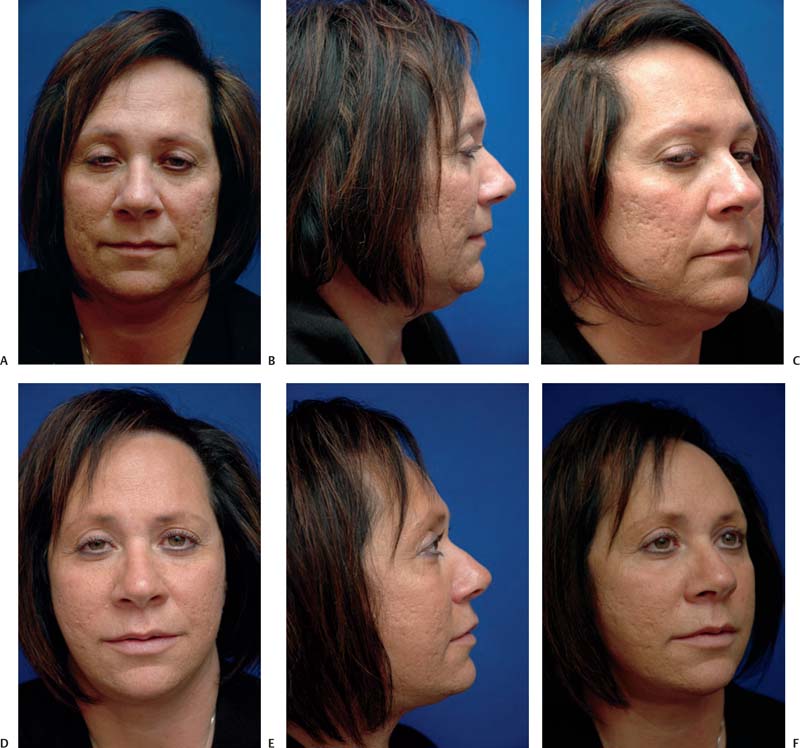
Fig. 12.5 (A–F) Photographs of the first of our patients to undergo SmartLifting with LaserSmartLift and a MiniLift in early 2008. Patient is shown (A–C) before and (D–F) after the procedure.
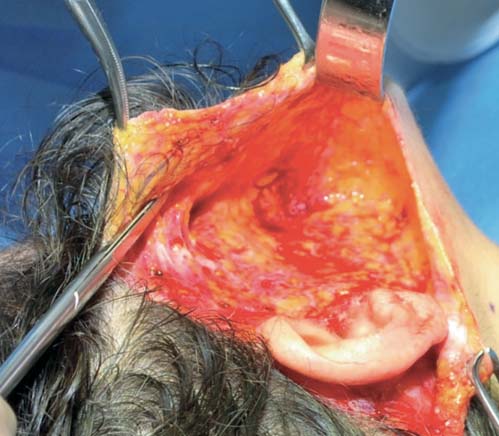
Fig. 12.6 Very dry surgical field with uncauterized laser-elevated facial skin flap. The surgical field beyond the incision is shown with very little bleeding to the point of 5.5 cm of dissection.
Clinical Study Establishes That Some Lasers Used in Lipolysis Are Not Strongly Hemostatic
Subsequent to the observations of early 2008 described above, and following discussions with the Cynosure Corporation about the clinical hemostatic properties we had observed with its lasers, we began to investigate other lasers’ intrinsic hemostatic properties when used before the elevation of a facial flap, and whether other fiber lasers showed an equal or proportionate hemostatic effect. With proper patient consent we compared the effects of the pulsed 1064-nm and pulsed 1064-/1320-nm lasers with those of a 980-nm continuous-wave (CW) diode laser. In these clinical studies we set the power of the lasers at 10W and completed the procedures we were examining. The results of our study indicated that although the 980-nm laser beam passed through subcutaneous tissue somewhat more easily that the 1064-nm or 1064-/1320-nm beams, the net hemostasis it produced was poor and the blood loss in the procedure was about the same as in a standard rhytidectomy without laser-enhanced hemostasis. Photographic documentation of our findings is shown in Figs. 12.7 and 12.8. The study was quantified on the basis of sponge use in completing the facelift procedure in which we compared the different lasers, and we found that roughly five times as many sponges were used in procedures done with the 980-nm CW diode laser as with the pulsed 1064-nm and 1064-/1320-nm lasers (Figs. 12.7B; 12.8C). Other clinical findings were that the patients treated with the 980-nm laser had more prolonged bruising, swelling, and induration after subcutaneous treatment with this laser than did those treated with the other two lasers, most probably from greater extravasation of blood into the superficial soft tissues. We also compared the SmartLipo lasers with a 1444-nm pulsed laser, which also failed to demonstrate hemostatic properties as significant as those of the 1064-nm laser and 1064-/1320-nm multiplexed laser.
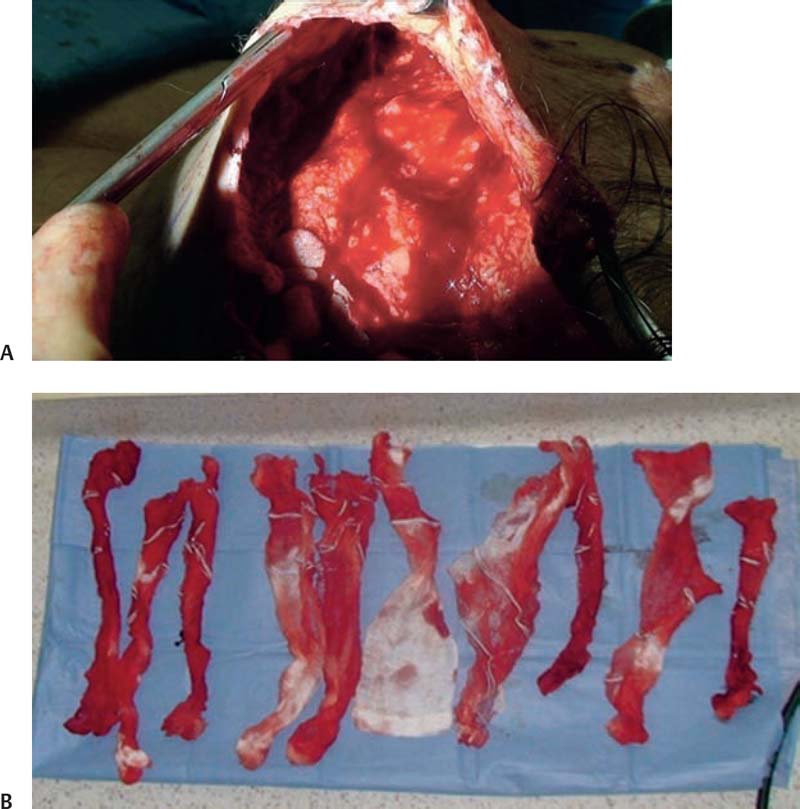
Fig. 12.7 (A,B) Flap elevated with the 980-nm CW diode laser, with poor hemostasis as based on a sponge count. Because of its pulse configuration, the 980-nm CW diode laser does not have strong hemostatic properties. The hemostatis with this laser was no better than for a traditionally elevated facelift flap. (A) Intraoperative view. (B) Sponge count with four times as much blood loss than with SmartLipo laser.
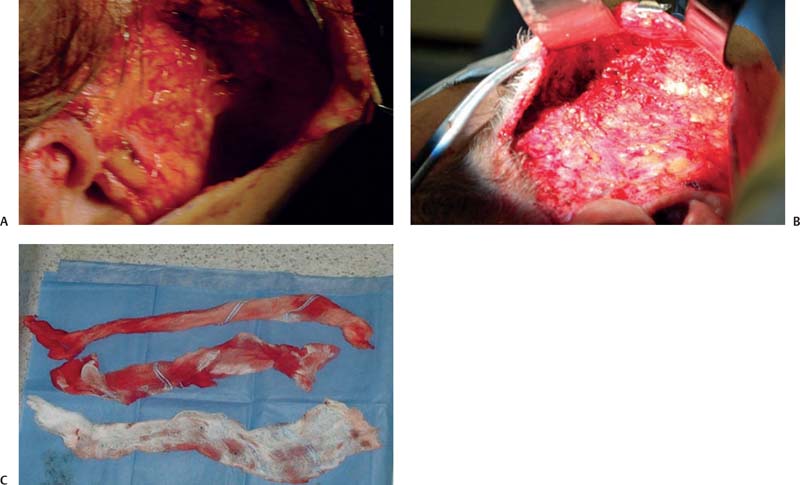
Fig. 12.8 The SmartLipo MPX laser shows excellent hemostasis in either the 1064 nm, 1320 nm, or blended mode. (A) Flap elevated with the Smartlipo MPX laser at 1320 nm. (B) Flap elevated with the SmartLipo MPX laser in 1064-/1320-nm multiplex mode. (C) Sponge count with flap elevation at 1320 nm.
SmartLifting Techniques
SmartLifting evolved from the application of two new technologies in facial surgery. The first is the use of subcutaneous laser techniques for hemostasis and for developing the facial flap of rhytidectomy in the best possible plane. The laser helps define the facial flap and creates a dissection plane by creating multiple microdissection tunnels (Fig. 12.9). We initially accomplished this with a low-wattage Nd:YAG laser and optical fiber introduced through a stainless steel cannula and operating at 6W. The advent of more powerful instruments for laser lipolysis has made it possible to use more optical energy, but rarely should the laser power setting for hemostasis and flap development exceed 15W. We generally use 9 to 12W of power for most areas of the face, and reserve the higher settings for possible use in patients with heavy necks, taking caution in treating necks with a very thin midline.
Stay updated, free articles. Join our Telegram channel

Full access? Get Clinical Tree


